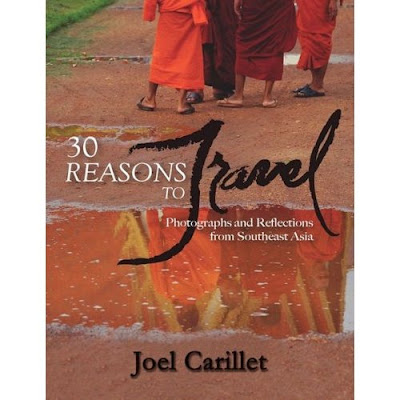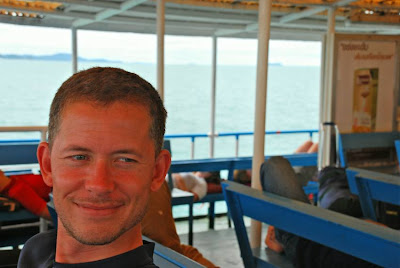One of the most incredible interculturalists I have ever met (and this is coming from an international educator!) is our Chief Editor here at Wandering Educators, Joel Carillet. He has traveled the world, and has taken many, many magnificent photographs. I have bought his photos for special gifts for friends and family - his photo of a Hmong woman's dyed hands, shown atop her gorgeous embroidery, has pride of place at my parents' house. Recently, Joel came out with his first book, entitled 30 Reasons to Travel: Photographs and Reflections from Southeast Asia. It is a treasure-trove of photos and text that encourage thinking and learning about travel, others, and the common joys of humanity. When flipping through the book, the photos stand out - and make me want to travel to Southeast Asia, immediately! Upon reading the poetic prose, I was immersed in places and cultures I've not yet experienced.

One of my favorite reasons to travel, in this book, was Bac Ha's Sunday Market. Joel describes the Vietnamese market, full of Flower Hmong in colorful costumes, "brought to mind a Henri Matisse painting run amok." The photos accompanying this essay, indeed, show us the bright colors and marvelous embroidery that this culture is so famous for.
Perhaps for me, the best of the book is the underlying premise that the choices that we make in life, and in travel, contribute to our experiences. As an intercultural educator, I truly believe that to explore a culture fully, we must open our eyes, hearts, and minds. This book does just that.
I was lucky enough to sit down and talk with Joel about his new book. Here's what he had to say...
WE: Please tell us about your new book, 30 Reasons to Travel...
JC: For several years I've published stories in magazine, anthologies, and on the web that dealt with specific places and people, but I've never had a format with which I could create an overarching argument for why travel is so valuable. 30 Reasons to Travel, my first book, gave me this format.
Through both word and image, the book invites the reader to consider how he or she is part of a journey that the world itself is already on. A lot of “list books” have been published in the last ten years (e.g., 1000 Places to See Before You Die), but what sets this one apart--in addition to its more than 275 photographs--is its more reflective nature. If you want a book that will tell you about plush hotels or the best places to get a tan, this isn't for you. But if you want to consider the beauty of laughter, the value of holding a child of another race, or what a meaningful souvenir may look like, you'll probably like 30 Reasons to Travel.
In putting the book together, I kept two interrelated realities in mind: First, not everyone can or does travel abroad. Second, many lessons of travel also have application in one's own home or neighborhood. And so each of the 30 reasons is intended to provide food for thought not only for those who travel but also for those who say close to home.
As for structure, the book is divided into 30 sections comprised of a short story or reflection accompanied by photographs.
WE: How did you narrow it down to only 30 reasons?
JC: Not a very exciting answer but here it is: time and money. My deadline to complete the book was very short, which led me to focus on 30 reasons instead of, say, 1000. But cost was also a factor. Because of the color photography, the larger the book became, the greater the final cost to the buyer was going to be.
WE: What is your travel philosophy? You're a very intercultural traveler...
JC: Neither I nor the book argue that there is only one way to approach travel. Each person is different and so what each person takes into the experience of travel is different.
Having said that, my philosophy--and what I encourage others to consider--is that travel is one of the best ways we have to enrich our understanding of what it means to be human. The Jewish philosopher Martin Buber wrote that “all actual life is encounter,” and I think he's right. Not only do we encounter new people abroad, we also encounter ourselves in a new way. We're enriched as we meet people, cultures, and issues outside our usual context, and hopefully others are enriched by us as well. Travel nurtures a sense of interrelatedness and leaves us dissatisfied with knowing the world merely through a television screen or newsprint, because travel shows us that you can't actually get to know the world this way--and on occasion get it just plain wrong.
I've talked to Muslims who looked almost awestruck as they described their pilgrimage to Mecca, relating what it was like to see so many cultures in one place, to experience a sense of brotherhood with people who came from countries or ethnicities that they had till now always had a negative perception of. As the hajj was for them, travel can be for me: a venue in which self-made borders and biases are forced to give way to the weight of actual encounter.
WE: Your photographs are magnificent. What are your favorite subjects to photograph?
JC: People, particularly people whose faces are shaped by years of joy and laughter…or by years of pain and sorrow.
WE: How can travelers truly experience a culture?
JC: A few quick thoughts:
First, read up a bit on the place you're visiting. If you're going to Vietnam, for example, read a good history of the country (my favorite is Stanley Karnow's aptly named Vietnam: A History) or a well-done novel set there (Graham Greene's The Quiet American is a quick read). And if you're going to a contentious setting like Jerusalem, try to read something written by a person from each side of the political divide (an absolute must-read book for this region is Sandy Tolan's: The Lemon Tree: An Arab, a Jew, and the Heart of the Middle East).
Second, make a point to learn a handful of local words and phrases.
Third, let a local resident know--often an English-speaking staff member at your hotel is a great interlocutor--that you'd like to step off the normal tourist trail, at least for a few hours, and see a neighborhood or home far from the museums and tourist hangouts. Many a hotel employee in Pakistan, China, Palestine, Thailand, Indonesia, and elsewhere has taken me into their home or into the homes of their friends. Through them I've gone to weddings, festivals, viewpoints, and eateries a guidebook alone would never have introduced me to.
WE: Is there anywhere that you can't wait to get back to?
JC: There's no place I've been that I wouldn't like to go back to, but among the top are Tibet (one really feels you are at a place where the Earth has pushed itself up to the heavens and the people have learned to live accordingly), Indonesia (a fascinatingly diverse archipelago that has as many volcanoes as America has Wal-Marts), and northern Pakistan (an utterly rugged landscape inhabited by a rugged, hospitable people).
WE: Is there anything else you'd like to share with us?
JC: Just thanks for the opportunity to answer your questions and share a little about the book!
WE: Thanks so much, Joel! It is inspiring, to see the gorgeousness of life in your book. Congratulations on creating such a beatufiul, timeless, and interculturalgem.
To learn more about Joel and his work, please see:
http://www.joelcarillet.com
To purchase 30 Reasons to Travel: Photographs and Reflections from Southeast Asia, please see Joel's site.
To read more of Joel's work here on Wandering Educators, please see:
http://www.wanderingeducators.com/user/joel-carillet
OR, click here to see his feature as our August Photographer of the Month!

